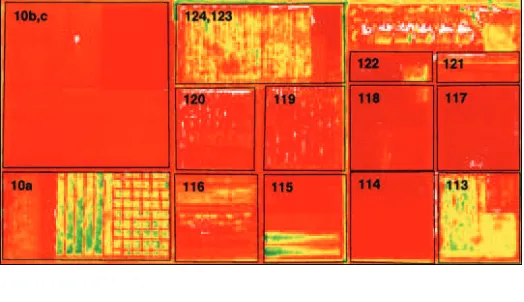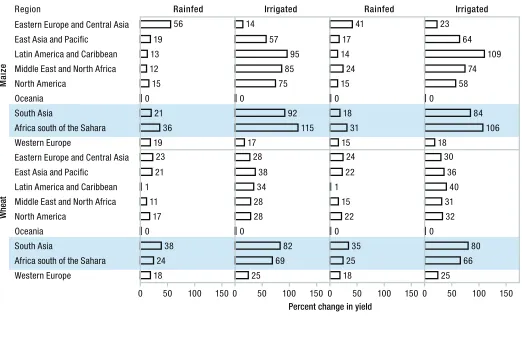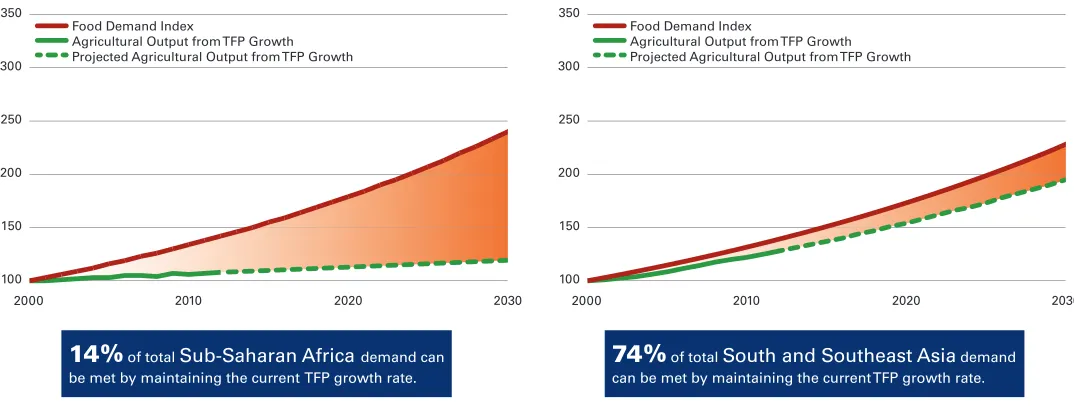www.ifc.org/thoughtleadership
NOTE 46 • OCT 2017
Precision Farming Enables Climate-Smart
Agribusiness
Emerging market countries, particularly India and nations in Sub-Saharan Africa, can beneit
from advanced farming technologies that mitigate the effects of climate change and protect environmental resources. Water scarcity is an issue that can be overcome by adopting climate-smart technologies such as micro-irrigation. There are several precision agriculture investment opportunities available to the private sector, including agricultural extension via digital advisory services, drip irrigation, solar pumps, and crop and soil monitoring.
Existing and developing technologies will have a major role in food production and food security in emerging markets. According to the International Food Policy Research Institute (IFPRI), the largest yield gain potential across the world’s key staple crops—maize, rice, and wheat—in percentage terms are in Africa, South Asia, and parts of Latin America. In a comprehensive attempt to identify the drivers of yield increase, IFPRI’s selection of technologies included:1
• No- and low-till farming
• Precision agriculture
• Soil fertility management (including nitrogen use)
• Drip and sprinkler irrigation
• Drought and heat tolerant seeds
• Crop protection
While IFPRI’s interim conclusions rank no-till farming as the practice most conducive to yield increase in the three crops tested, it notes that the interaction of multiple practices applied simultaneously will almost certainly produce the best results.
Along the same lines, field tests over the past 30 years showed that applying soluble or liquid fertilizers through drip systems contributed to input saving, direct plant utilization, and reduced chemical pollution.
Despite the definitive advantages of these technologies (Figure 2), there is near zero adoption of drought tolerant seeds and little adoption of precision agriculture tools, drip
irrigation, and sprinkler irrigation in Sub-Saharan Africa and most of India.2
India’s potential model for change
Building capabilities to sustain the adoption of more precise farming practices, rather than the full implementation of single factors, will produce the quantum leap necessary in India and Sub-Saharan Africa. (In fact, building access to crop and site-specific technical knowledge and developing management capabilities is a precondition to improving
FIGURE 1 Soil and crop monitoring: measuring
the water deicit
he image shows water deicits in individual ields, measured by a NASA aircrat lying over the Maricopa Agricultural Center in Arizona, USA. Green and blue colors indicate wet soil; red indicates dry soil. Source: NASA,
yields anywhere in the world.) In that context, some of India’s leading states may provide important lessons to be applied elsewhere.
India is an agricultural giant with 194 million hectares of gross-cropped area, 66 million hectares of net irrigated area, and 127 agro-climatic zones. India’s central and state governments have been proactive in addressing obstacles to the agricultural sector, which employs about half of the workforce and accounts for almost 7 percent of GDP. Despite robust subsidies for electricity, micro-irrigation, and fertilizers, rates of adoption for these technologies have been low, except in Gujarat.
The lack of efficient knowledge dissemination tools is pervasive in India’s agriculture sector. Despite government efforts to provide agronomic support, most farmers remain far from adopting available technologies due to a lack of effective transfer mechanisms. The model implemented by the Gujarat Green Revolution Company (GGRC) integrates input subsidies, primarily for micro-irrigation and fertilizers, with manufacturers’ on-farm support and equipment performance warranty, both prerequisites to qualify as certified suppliers.
Gujarat’s Micro Irrigation Scheme gained popularity through the provision of electricity connections on a priority basis to those farmers who adopt Micro Irrigation Systems, or MIS. Unique features of the scheme include bank loan support for farmers and insurance coverage for both the system and the farmer for one year. The strength of the scheme lies in its flexibility and transparency, including discretion for participating farmers to choose the type of MIS they prefer.
Farmers can also choose the area to be covered under MIS and the suppliers who install it, provide agronomical services for one year, and maintain the system for a period of five years. The scheme enabled the transition of over one million hectares to MIS in the last decade.3
As part of the effort to re-energize the second Green Revolution campaign, Gujarat’s model is now being emulated by other states. In parallel, community projects supported by local governments group together thousands of small farmers to overcome the inherent disadvantages of scale (for example, Karnataka’s Ramthal Community Irrigation4 and Tamil Nadu’s Community Collaborative Water Management initiatives).5 Given the appropriate financial and human resources, Gujarat, Karnataka, and Tamil Nadu offer critical lessons that may be applicable in some Sub-Saharan African countries.
Key barriers and the private sector role
IFPRI’s agronomic assessment of potential drivers point to necessary but insufficient factors to increase yields. Public and private initiatives must address additional local and regional factors that constrain investments at the farm level, including:
• Infrastructure transportation to serve domestic markets, intra-regional trade and export
• Cold-chain transportation and storage
• Extension services that research and disseminate agricultural knowledge
• Modern test-lab facilities and capabilities
• Smartphone networks to support digital communication in rural areas
• Adequate commercial financing
• Safe and predictable power and water supply.
The public and the private sector can work together in partnership to disseminate technology, knowledge, and inputs. Public extension networks can set a competitive stage through policies and programs, and private extension systems can directly support projects. The private sector can also fund research, commercial financing, insurance, digital knowledge dissemination, crop quality assurance and more.
Yet there is no substitute to public investment in physical infrastructure in roads, communication, and power, as well as institutional reforms that enable fair land consolidation, reduce bureaucratic barriers and unequivocally fight corruption. In that context, both Sub-Saharan Africa and India face challenges that inhibit private investment.
FIGURE 2 Yield increase response to no-till and irrigation under less-hot (left) and hotter (right) climate change 2050
Source: IFPRI, 2014.
Rainfed Irrigated Rainfed Irrigated
0 50 100 150 0 50 100 150 0 50 100 150 0 50 100 150
Percent change in yield
M
aize
Wheat
Region
Smart and precise agriculture investment opportunities
Can the most food-insecure countries dramatically increase their farming productivity with minimal impact on the environment? A qualified “Yes” is the answer broadly agreed upon, as are the necessary measures to achieve that goal.
Climate-smart agriculture is necessary to achieving the goal, and precision agriculture—at the appropriate level in food insecure countries—can also be a powerful tool when applied appropriately, based on local crop and site specific conditions.
The reality is that it is still possible to farm relatively
effectively and competitively with little precision technology.
Consequently, the adoption of new techniques in less developed areas should start with a basic, affordable, and effective mix of technologies and practices. In a multiple-variables scenario, where all means are important, close examination invariably teaches that they are not all equally important.
Identifying the low hanging fruit is critical to setting a complex project in motion, certainly more so when the private sector is involved. And return on investment is a dominant factor.
The immediate benefits for small-scale farmers and
potential investment opportunities from the introduction of such a mix of inputs, technologies, and capabilities in Sub-Saharan Africa and India include:
1. Agricultural Extension via Digital Advisory Services:
“Technology alone is not a silver bullet,” according to the Gujarat Green Revolution Company. Adoption of best practices is critical, and digital communication is necessary to bridge the technology gap. Basic smartphones can bring digital agronomic support provided by human advisors to millions of farmers.
Reaching out to millions while keeping the trust of person-to-person advice is the challenge of effective adoption. Communication should flow between advisors and individual farmers, and it should support crop planning and management on a constant basis. Agro-advisory networks are crucial in the Indian and Sub-Saharan African agriculture sectors, given that the choice of inputs and methods of cultivation determine both the financial viability of farms and the optimal conservation of land, water, and energy. Public support would be particularly beneficial for allowing platform building, including data platforms. Private engagement could then be increased via competition on the
platform and extended reach of farmers through it.
No- and low-till farming greatly reduce soil disturbance, which reduces soil erosion, builds soil organic matter, and helps reduce machine energy cost and pollution. It must be done properly to avoid weed propagation. The accumulated and frustrating experience in Sub-Saharan Africa and other parts of
FIGURE 3 Food demand compared to agricultural output from total factor productivity (TFP) growth in Sub-Saharan Africa and South & South East Asia 2000–2030
TFP measures changes in the eiciency with which all inputs are transformed into outputs; here understood as farmers who use inputs more precisely and eiciently, or adopt improved cultivation and livestock practices. Source: Global Harvest Initiative, 2015 Global Agricultural Productivity Report, 2015, pp. 12-13. www.globalharvestinitiative.org/GAP/2015_GAP_Report.pdf
2000 2010 2020 2030
Food Demand Index
Agricultural Output from TFP Growth Projected Agricultural Output from TFP Growth
100 150 200 250 300 350
14%
of total Sub-Saharan Africademand can be met by maintaining the current TFP growth rate.2000 2010 2020 2030
Food Demand Index
Agricultural Output from TFP Growth Projected Agricultural Output from TFP Growth
100 150 200 250 300 350
the world show that introduction and implementation
do not equal adoption. Digital Advisory Services, or DAS, can be the standard tool for existing extension networks and holds the key to adoption and, unlike other inputs, requires no investment from farmers.
Agricultural extension plays a key role in technology dissemination, and the private sector is increasingly active in this domain. Today, Digital Advisory Services are either part of the offering of input providers or stand-alone for profit, typically start-up platforms. In the first case and with few exceptions, existing free
DAS is a differentiation tool to promote the use of manufacturers’ core products. In the second case of for-profit stand-alone platforms, farmers are the revenue generators, and its application to small farms in food-insecure areas is far-fetched.
A recent assessment of privately supplied farmer advisory services examined the situation in ten countries. Four of the case studies came from India. In these instances, the study identified considerable benefits from extension by commercial actors. Their advice helped improve yields, natural resource management, consistency of produce quality, and net farm profits.6 The opportunity for investors may be found in free and brand-neutral platforms that produce
non-prescribing analytics that enrich human advisors. Free-of-charge systems should drive mass utilization and Big Data value for large agribusiness players. At a later stage, investors may benefit from Big Data’s appeal to mass communication and advertising platforms. The main barriers to DAS adoption are limited digital infrastructure and illiteracy, areas where India has significant advantages over most of Sub-Saharan Africa.
2. Drip irrigation: In addition to its advantages over other
types of irrigation for improving yields, drip irrigation is the best delivery system for soluble fertilizers. It also drastically reduces the propagation of weeds and the need for herbicides. The private sector is well prepared to lead here. Foreign—principally Israeli— and local leading brands dominate the established micro irrigation market in India. Additionally, local adjacent large firms are considering or have already entered it. The introduction of drip and micro irrigation is estimated to cover no more than 10
percent (approximately $1 billion) of its over 40 million hectares’ potential. Heavy governmental support seems to be granted for the foreseeable future, and absent
technologic breakthroughs, investment in the sector should consider acquisition of or partnership with incumbent firms.
Sub-Saharan Africa, with a few exceptions including South Africa, is a relatively new frontier for micro irrigation, with no established market or market leaders. The main barriers to adoption are capital expenditure financing and advisory services. Despite the numerous obstacles to the technology, the gap between a growing population and inefficient agriculture makes the region an attractive opportunity for long term investors.
3. Solar Pumps: Solar pumps that lift well water to
feed drip systems are a benefit multiplier. Yet the introduction of solar pumps is slow despite their zero-carbon footprint and low-maintenance photovoltaic technology. According to official estimates, over twenty million well pumps operate today in India, roughly split between electric and diesel.7 At a solar unit cost ranging from $1,500 to $10,000 for multiple farmers, this potential multi-billion dollar market is already a target for local and foreign manufacturers
The initial cost of solar technology coupled with the established maturity of electric and diesel pumps (and subsidized electricity) are among the major barriers to solar pump adoption. Changes to subsidy policies now underway may help pave the way for mass adoption and hence further increase the role of private firms contributing to the proliferation of solar pumps.
4. Soil and Crop Monitoring: Imagery-equipped drones
are often technically and financially affordable for small farmer communities or regional operations. Accurate regional weather forecasts can provide data relevant to the spread of diseases and pests. Monitoring and Predictive technologies seem applicable while algorithm-based prescriptive systems may not suit most of the necessary support. Drones’ sensing is particularly suited for small plots and contract farming. Small farms can benefit from quality and timely information that can drive corrective actions and prevent crop failures due to defective irrigation and fertilization.
agri-businesses, the investment in drones and imagery analysis can be factored into the produce price paid to farmers. Investments by cooperatives of farmers supported by soft credit may reap similar benefits. Extending the usage of equipment for soil and crop monitoring to farming cooperatives and contract farms also benefits from new forms of capex utilization led by the private sector, now spreading from developed countries into emerging markets.8
These technologies by no means discount the crucial role played by quality seeds, judicious pest and disease control, and other ground-based or remote sensors, all of which can be adopted by better informed farmers. New technologies aimed at optimizing input utilization—for example robots, variable rate seeding, and irrigation—are being developed and their introduction to small scale farms may be applicable in the future. At present, every solution should be integrated and should have basic characteristics:
• Easy-to-use systems: simple and fast setup, yet accurate enough to provide advice focused on the farmer’s needs.
• Minimum requirements for support and maintenance: minimal dependence on farm-specific communication infrastructure and in-field hardware.
• Flexible digital interfaces: easy and free building capability for users.
Conclusion
Climate smart farming techniques can increase agricultural productivity and farmer income, make rural communities more resilient, and mitigate climate change. Precision agriculture is part of the solution to feeding a population that is growing faster than available land supply, while also ensuring the sustainable use of water and energy. Per capita agricultural output in Sub-Saharan Africa and India is far below potential, mainly due to outdated
technologies and practices that result in low productivity and overdependence on nature.
Given the proper regulatory environment and institutional support, foreign and local private corporations seem willing to explore the opportunity and invest where needed. Small-scale farming, which is not inherently conducive to capital intensive modernization or the easy adoption of updated agronomic knowledge and methods, should be considered a challenge that we can meet.n
ABOUT THE AUTHOR
Igal Aisenberg is a leading Israeli executive in global agriculture and Agtech start-ups. He spent 25 years at Netaim, Tel Aviv, Israel, including as its President and CEO from 2009–14. ([email protected])
ACKNOWLEDGMENTS
The author would like to thank the following colleagues for their review and suggestions: Nina Zegger, Global Head, Global Climate Business, Manufacturing, Agribusiness and Social Services, IFC; Anup Jagwani, Principal Investment Oicer, Agribusiness and Forestry, Manufacturing,
Agribusiness and Social Services, IFC; Thomas Kerr, Principal Industry Specialist, Climate Policy Team, Climate Business, IFC; Marcene Broadwater, Global Head, Climate Strategy & Business Development, Climate Business, IFC; and Thomas Rehermann, Senior Economist, Thought Leadership, Economics and Private Sector Development, IFC.
ADDITIONAL NOTE ABOUT CLIMATE SMART AGRIBUSINESS
This note is one of two EM Compass Notes about private sector opportunities within Climate Smart Agribusiness. The second note focuses on the reduction of food losses and was concurrently published as EM Compass Note 47.
For media queries, please contact Nadine Ghannam: [email protected].
1 Food security in a world of natural resource scarcity: The role of agricultural technologies, International Food Policy Research Institute, 2014. 2 Ibid.
3 Gujarat Green Revolution Company Ltd.; http://ggrc.co.in/webui/home.aspx.
4 Government of Karnataka and 2030 WRG launch Karnataka Multi-Stakeholder Platform for Water to Drive Large-Scale Transformation in Water
Resources Management, 2030 Water Resources Group, May 23, 2017.
5 Community Collaborative: Water Management - Tamil Nadu Irrigated Agriculture Modernization and Water Bodies Restoration and Management
Project, World Bank Group, June 7, 2016,
6 Yuan Zhou and Suresh Babu, Knowledge Driven Development: Private Extension and Global Lessons, 2015. 7 Godyal, Anjali – Iha, Vikas, Solar water pumps for efficient irrigation, Indiawaterportal.org, Feb 18, 2017.


